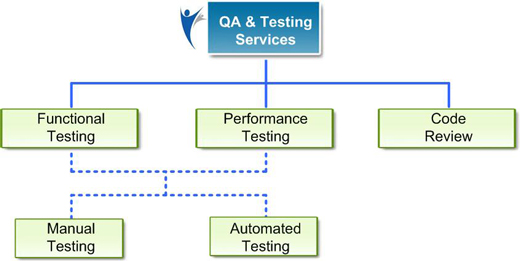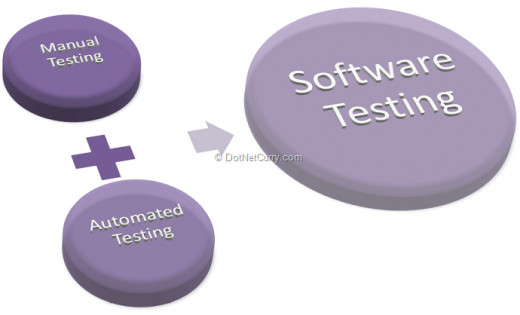A Handy Guide to Software Testing!
Software testing is simply the process of evaluating a system or software item to find out whether it is working according to the organization's specific requirements or not. It is performed to determine the quality of the product and is usually carried out during the development process. We can say that the software testing is a verification and validation process.
The verification process is the one that ensures that the particular product fulfills the specified conditions during the initiation of the development phase. Whereas, validations process ensures that the products satisfy the particular demands at the end of the development phase.
Overall, testing is the process that assists in identifying any flaws, errors or any gaps in contrary to the specified requirements of the clients.

Basics of software testing
Being an activity in the process of developing a software, software testing generally categorized into three main parts:
Black box testing: Black box testing is also known as functional testing. It is a technique that deals only with the output generated against any input and execution of the system. In this type of testing, the tester doesn't know the internal workings of the system. To perform this testing, the tester only needs the specifications of the program. He/she is not required to have further knowledge of the program or examine the programming code. This testing is mainly used for validation. Let's have a glance over some of the advantages and disadvantages of black box testing.
Advantages:
This testing is balanced and unbiased as both the tester and developer are independent of each other
This testing is highly efficient when used on large systems
Tester doesn't need to be technical
Test is performed from end user's point of view
Test cases can be designed soon after the completion of functional specifications
Disadvantages:
This testing is quite challenging without a clear picture of functional specifications
Test cases that are developed independent of the provided specifications make it difficult to identify the tricky inputs
Writing test cases are quite difficult
There are chances that several program paths will go untested
White box testing: There are various other names for this type of testing such as glass box testing, clear box testing, open box testing, path driven testing, structural testing and logic driven testing. This type of testing is a technique that examines a program structure and derives test data from the program code. Unlike black box testing, white box testing deals with the internal workings of a system or application. This testing is generally used for verification. Let's find out the advantages and disadvantages of white box testing.
Advantages:
As the tester is aware of the internal workings of the system, it becomes easier for him to determine which type of data can assist in testing the application effectively
This testing helps in revealing the errors in hidden code
Help in eliminating the useless lines of code that can bring in hidden defects
White box testing is also helpful in optimizing the code
Disadvantages:
A detailed knowledge of programming language is required to perform this white box testing
This testing is quite expensive as it requires both time and money
Sometimes it may not possible to look into each bit of code to detect the hidden errors, which may result into the failure of the application
Gray box testing: Gray box testing, which is also known as translucent testing, is the combination of both the white box testing and black box testing. In this type of testing, the tester is aware of the some parts of the internal structure of the code. The gray box testing is usually used to test the web services applications and also for functional or domain testing. Let's have a look upon the advantages and disadvantages of this testing.
Advantages:
This testing offers the combined benefits of both the black box testing and white box testing
Gray box testing is generally based on functional specification
This testing is unbiased as it maintains the boundary between the independent testers and developers
Disadvantages:
Gray box testing doesn't allow to perform the complete white box testing
When performed for a distributed system, it becomes difficult to associate defects
Most of the cases under this testing are difficult to design
It is not considered as the efficient testing because the tester is not having the complete knowledge of the process

Types of software testing
There are various types of software testings that are performed to identify the difference between the current input and the expected output of a process. Some of the testings are mentioned below:
Unit testing: Unit testing comes under the category of white box testing. It is the testing of an individual unit or group of related units. This testing is mainly performed to find out the whether the particular system is producing the expected output against the provided input or not.
Functional testing: Functional testing generally comes under the category of black box testing. This testing is mainly performed to make sure that the particular functionality that is needed in the system requirements is working efficiently.
Integration testing: Integration testing usually belongs to both the categories, the black box testing and the white box testing. Under this type of testing, a group of components is gathered to produce an output.
Performance testing: It comes under the category of black box testing. As the name suggests, performance testing is performed by the tester to determine the performance of a system in terms of its speed and effectiveness within the specified period of time.
System testing: System testing also comes under the category of black box testing. It is usually performed by the tester to make sure that the particular software works effectively in various environmental conditions.
Acceptance testing: Acceptance testing that comes under the category of black box testing is done to ensure that the output meets the specified requirements and the conditions of the client.
Stress testing: It also comes under the category of black box testing. This testing is performed by the tester to determine the behavior of a particular system under various unfavorable conditions.
Beta testing: Beta testing is a kind of black box testing that is performed by the end users to cover the unexpected errors.
Usability testing: This testing also belongs to the black box testing and is generally performed to evaluate a product by testing it on the users.
Regression testing: It also comes under the category of black box testing. Regression testing is generally performed after the modification of a system to determine whether the modification is working efficiently or not without causing any damage to the expected outcome.
Who does testing or what are the designations available for testers?
A software tester is a person who performs the testing on various systems to make sure that it meets the specified requirements of the client. These days, software testers are widely in demand and lots for testing jobs are generated by various small and big organizations. Depending upon the process and responsibilities of the job assigned, testers are given various designations like software tester, software quality assurance engineer, QA analyst, project lead, project manager, etc.

Ways to test a software
A software can be tested in two ways: manual testing and automation testing
Manual testing: Under this type of testing, the tester plays the role of an end-user and performs testing without using any automated tool to find out any kind of flaw or bug. This testing comprises various stages such as unit testing, integration testing, system testing and acceptance testing.
Automation testing: Under this type of testing, the tester makes use of another software to test the given product and writes scripts. As compared to manual testing, the automation testing is less time consuming, inexpensive and delivers accurate results.
To conclude, testing is a very broad term and plays an imperative role in the various organization. As the demand of new software is on rise with various features among customers, companies are looking for the software testers who can assist them in delivering the software that are free from bugs and can enhance the user experience, which will ultimately improve the quality impression of the particular company.



